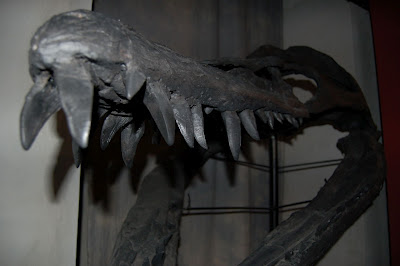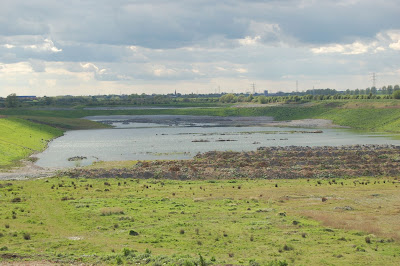

| Visitors Now: | |
| Total Visits: | |
| Total Stories: |

| Story Views | |
| Now: | |
| Last Hour: | |
| Last 24 Hours: | |
| Total: | |
In Search of Pliosaur Pefection
Thursday, September 20, 2012 20:32
% of readers think this story is Fact. Add your two cents.
I would imagine that the ultimate aim for any aspiring vertebrate field palaeontologist is to find a new species or perhaps find as perfect and articulated a specimen as could possibly be discovered. Of course, both are incredibly difficult to achieve but that does not mean that it is impossible and consistent sampling in the correct rocks should, on the face of it, eventually produce the goods and even the most heavily sampled formations in the world continue to throw up surprises.
The Morrison Formation of North America is just such a place and, even after nearly 140 years of field work, continues to produce and there are still new dinosaur taxa to be announced in the not too distant future. Other highly productive formations, such as the Hell Creek, Two Medicine and Dinosaur Park also, from time to time, throw up something new and throw a spanner into the sometime static dinosaurian status quo. Micropalaeontology also reveals that some formations have yet to yield many dinosaurian taxa since, although there are quite often teeth that are identifiable at the generic level, there is a distinct lack of skeletal remains to identify the specific owners of these teeth and there is the likelihood that some of these will be new to science.
Of course, formations such as these are not just restricted to North America and some are much closer to home. The Oxford Clay Formation in the UK is one of these and is one of the most heavily sampled and best known fossil lagerstättenin the world and yet even now new specimens are still occasionally described (Cruickshank et al 1996; Ketchum & Benson 2011) and those of us who work in the strata are continually surprised at what pops up from time to time.
There is no doubt, however, that workers today are at a serious disadvantage when it comes to new specimens being located. The golden age of discovery, such as when the Leeds brothers amassed their vast collections, was during the late 1800’s to the early 1900’s. During this period house building was at its peak and demand for bricks was high and, since this was during the days before mechanisation, most clay was removed from the quarries by hand. This, of course, allowed for a far greater discovery of vertebrate fossils and many fine specimens were removed. Indeed, it was common practice for workers to be paid for every bucket of fossils they produced – a tactic used during the earliest days of fossil bone collecting. Mantell was one of the first and many others over the years have employed the same tactic.
The onset of mechanisation changed everything and the discovery of relatively complete articulated specimens began to drop off although new specimens were continually found throughout the 20thcentury. As mechanisation became more complex and the spectre of health and safety came to the fore during the 80’s and 90’s then the amount of specimens continually diminished with only a small proportion being recovered after being located by permitted visiting groups. The time of anyone asking to be allowed into a quarry to look for fossils as a hobby was over; this was also a loss, because several important specimens were located by these dedicated amateurs.
Today, there are hardly any quarries left and those that remain are heavily regulated and access is nearly always denied. However, the clay is still the same as it ever was and there must be many fine specimens still awaiting discovery. Chief amongst these, and the ultimate aim for somebody like me, are the pliosaurs – especially Liopleurodon.
 |
| A big Liopleurodon tooth comes to light |
Liopleurodon was one of the largest pliosaurs and is easily comparable to other well-known animals such as the Westbury Pliosaurus (Sassoon et al 2012), the as yet undescribed Dorset giant that made the news last year and the badly managed monster, the so called “Predator X”, from Svalbard within the Arctic Circle.
The skulls of these large pliosaurs are immense, approaching 3 metres in length, and are capable of producing an incredibly powerful bite force. This power was generated by enormous muscles and the muscle attachments on the lower jaw are massive and were coupled with a neck that was also heavily muscled. This massive head was propelled by an enormous and powerful body and this combination made these marine reptiles the super predators of their day.
Interestingly, however, preserved stomach contents for big pliosaurs are rare. One particular Liopleurodonspecimen from the Oxford Clay was said to display fish scales and belemnite hooklets and little else – apart from a few stones – but this specimen was apparently a juvenile and may not reflect the actual dietary preferences of an adult.
However, it is pretty obvious that these macro predators were not content with merely munching on fish and squid. Approaching 15 metres in length and maybe more, large pliosaurs would have needed larger prey to sustain their large body size and their contemporaries in the oceans would have fitted the bill nicely. There are numerous bones from plesiosaurs and marine crocodiles that display predation marks including puncture wounds, scraping and evidence of chewing – and these quite clearly demonstrate morphologies indicating that large pliosaurs such as Liopleurodonwere the most likely perpetrators.
It would be amazing to locate a big, fairly complete articulated pliosaur from the Oxford Clay – especially Liopleurodon. Just before Quarry 4 was closed, we were starting to find bits and pieces including teeth and a large vertebra from this pliosaur but we ran out of time and were unable to locate any more bone and, as you cans see from the photograph below, the quarry is slowly being returned to nature and gradually filling up with water. The Liopleurodonsite is now buried forever which is a shame but one of those things.
So a big articulated pliosaur with a complete skull loaded with teeth, around 30 feet long with every single bone in place – that would do nicely! Ah – we can dream. Maybe one day……..
References
Cruickshank, Arthur R I, Martill, David M and Noè, Leslie; 1996; A pliosaur (Reptilia, Sauropterygia) exhibiting pachyostosis from the Middle Jurassic of England; Journal of the Geological Society of London; 153 pp.873-879
Ketchum, H.F. and R. B. J. Benson. 2011. A new pliosaurid (Sauropterygia, Plesiosauria) from the Oxford Clay Formation (Middle Jurassic, Callovian) of England: evidence for a gracile, longirostrine grade of Early-Middle Jurassic pliosaurids. Special Papers in Palaeontology 86:109-129
Sassoon, J., Noé, L. F. and Benton, M. J. (2012), Cranial anatomy, taxonomic implications and palaeopathology of an Upper Jurassic Pliosaur (Reptilia: Sauropterygia) from Westbury, Wiltshire, UK. Palaeontology, 55: 743–773. doi: 10.1111/j.1475-4983.2012.01151.x
2012-09-20 20:07:23
Source: http://saurian.blogspot.com/2012/09/in-search-of-pliosaur-pefection.html
Source:




